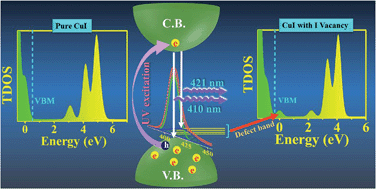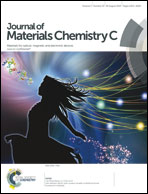Tailored defect-induced sharp excitonic emission from microcrystalline CuI and its ab initio validation†
Abstract
Defect rich structures of metal halide-based ionic semiconductors are a major problem owing to their prospective applications in a broad range of light emitting devices, such as ordinary light emitting diodes to more exotic laser diodes. As a consequence of the inherently low formation energies of the native defects, especially in cuprous iodide (CuI), it is difficult to achieve band edge excitonic emission as it is often quenched by a defect center-mediated radiative recombination. Herein, we report an in situ room temperature technique for fabricating highly crystalline CuI films on transparent and flexible polyethylene terephthalate (PET) substrates. The as-prepared samples were found to exhibit signatures of sharp excitonic emission. Optimization of the reaction parameters revealed the pH of the solution to be a pivotal parameter for controlling such excitonic emissions. Although all as-grown films were observed to be highly crystalline in nature, varying concentrations of iodine were found to manifest its effect by evolving a crystal morphology from microrods to polyhedrons. Further theoretical investigations using density functional theory were also carried out to investigate how the breakage of the Cu–I bond contributes to the development of such defects. The less defective films with a sharp excitonic band are speculated to be a potential candidate for solid state light emitting devices.


 Please wait while we load your content...
Please wait while we load your content...